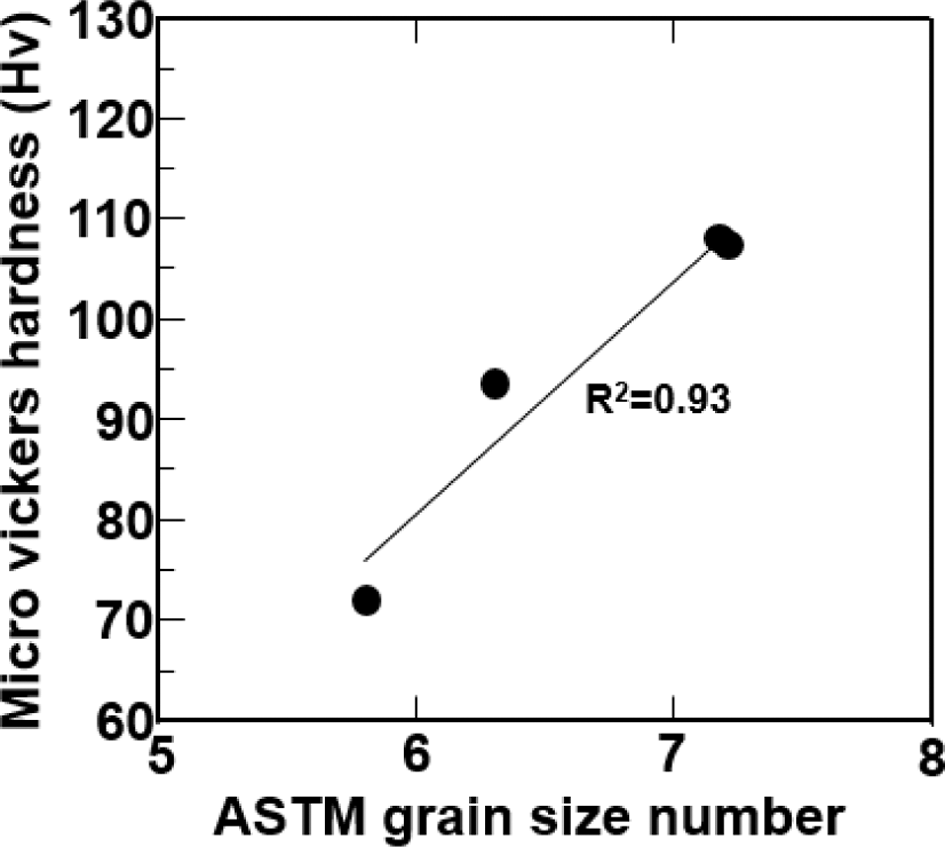Search
- Page Path
- HOME > Search
- [Korean]
- Investigation for Microstructure and Hardness of Welded Zone of Cu-Ni Alloy using W92-Ni-Fe Sintering Tool
- Tae-Jin Yoon, Sang-Won Park, Myung-Chang Kang, Joong-Suk Noh, Sung-Wook Chung, Chung-Yun Kang
- J Korean Powder Metall Inst. 2015;22(3):181-186. Published online June 1, 2015
- DOI: https://doi.org/10.4150/KPMI.2015.22.3.181

- 540 View
- 2 Download
-
 Abstract
Abstract
 PDF
PDF In this study, the effect of the friction stir welding (FSW) was compared with that of the gas tungsten arc welding (GTAW) on the microstructure and microhardness of Cu-Ni alloy weldment. The weldment of 10 mm thickness was fabricated by FSW and GTAW, respectively. Both weldments were compared with each other by optical microstructure, microhardness test and grain size measurement. Results of this study suggest that the microhardness decreased from the base metal (BM) to the heat affected zone (HAZ) and increased at fusion zone (FZ) of GTAW and stir zone (SZ) of FSW. the minimum Hv value of both weldment was obtained at HAZ, respectively, which represents the softening zone, whereas Hv value of FSW weldment was little higher than that of GTAW weldment. These phenomena can be explained by the grain size difference between HAZs of each weldment. Grain size was increased at the HAZ during FSW and GTAW. Because FSW is a solid-state joining process obtaining the lower heat-input generated by rotating shoulder than heat generated in the arc of GTAW.
- [Korean]
- Effects of Welding Conditions and Material Arrangement on Tensile Properties of Friction Stir Lap Welded of Dissimilar Al Alloy, A5J32/A5052
- Tae-Jin Yoon, Myung-Chang Kang, Chung-Yun Kang
- J Korean Powder Metall Inst. 2013;20(4):302-307.
- DOI: https://doi.org/10.4150/KPMI.2013.20.4.302

- 509 View
- 0 Download
- 2 Citations
-
 Abstract
Abstract
 PDF
PDF - A5J32-T4 and A5052-H32 dissimilar aluminum alloy plates with thickness of 1.6 and 1.5 mm were welded by friction stir lap welding (FSLW). The FSLW were studied using different probe length tool and various welding conditions which is rotation speed of 1000, 1500 rpm and welding speed of 100 to 600 mm/min and material arrangement, respectively. The effects of plunge depth of tool and welding conditions on tensile properties and weld nugget formation. The results showed that three type nugget shapes such as hooking, void, sound have been observed with revolutionary pitch. This plunge depth and material arrangement were found to effect on the void and hooking formation, which in turn significantly influenced the mechanical properties. The maximum joint efficiency of the FSLWed plates was about 90% compared to base metal, A5052-H32 when the A5052-H32 was positioned upper plate and plunge depth was positioned at near interface between upper and lower plates.
-
Citations
Citations to this article as recorded by- Effects of Rotation Speed on Microstructure and Mechanical Properties in Ti/Cu Dissimilar Friction Stir Welding
Yong-Jae Lee, Won-Ki Jung, Se-Eun Shin, Dong-Geun Lee
Korean Journal of Metals and Materials.2021; 59(12): 886. CrossRef - Investigation for Microstructure and Hardness of Welded Zone of Cu-Ni Alloy using W92-Ni-Fe Sintering Tool
Tae-Jin Yoon, Sang-Won Park, Myung-Chang Kang, Joong-Suk Noh, Sung-Wook Chung, Chung-Yun Kang
Journal of Korean Powder Metallurgy Institute.2015; 22(3): 181. CrossRef
- Effects of Rotation Speed on Microstructure and Mechanical Properties in Ti/Cu Dissimilar Friction Stir Welding
TOP
 KPMI
KPMI


 First
First Prev
Prev


